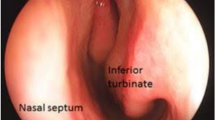Abstract
This study was designed to assess the surgical outcomes of two commonly used techniques for turbinate reduction (diode laser and bipolar diathermy) in selected group of patients with chronic nasal obstruction which resulted from inferior turbinate hypertrophy. The current study was conducted on adult patients with a diagnosis of inferior turbinate hypertrophy. 42 patients (21 in each group) with an age range of 21–38 years (mean = 26.0 ± 4.1) were included in this work and were randomly distributed in 2 groups: one group was scheduled for diode laser turbinectomy (DLT) while the other group was managed by bipolar diathermy (BDT). In DLT, the machine was on a continuous mode with intermittent loading, with laser energy level set to 6 W (0.3-s pulse, 0.1-s break). Pre- and postoperative assessments were statistically compared via tests from SPSS 19.0 (IBM, Chicago, Illinois; USA). Percentage of categorical variables were compared using the Chi-square (χ2) test. P < 0.05 was considered significant, P˃0.05 was considered non-significant, and P < 0.001 was considered highly significant. At 6 months postoperatively, in cases of DLT, there was high significant improvement as regards nasal obstruction and headache (χ2 = 64.78 and 39 respectively; P < 0.0001). There was insignificant difference as regards rhinorrhea (χ2 = 5.524; P = 0.137). In comparison to the postoperative data of both groups, significant difference was reported as regards nasal obstruction and headache (P < 0.001) and rhinorrhea (P < 0.05). This study demonstrated that both laser and bipolar cautery are effective in improving nasal obstruction and rhinorrhea. Preservation of the nasal mucociliary function was better in the diode laser group.





Similar content being viewed by others
References
Huang T, Cheng P (2006) Changes in nasal resistance and quality of life after endoscopic microdebrider-assisted inferior turbinoplasty in patients with perennial allergic rhinitis. Arch Otolaryngol Head Neck Surg 132:990–993
Swift AC, Campbell IT, McKown TM (1988) Oronasal obstruction, lung volumes, and arterial oxygenation. Lancet 1:73–75
Willatt D (2009) The evidence for reducing inferior turbinates. Rhinology 47:227–236
Li KK, Powell NB, Riley RW, Troell RJ, Guilleminault C (1998) Radiofrequency volumetric tissue reduction for treatment of turbinate hypertrophy: a pilot study. Otolaryngol Head Neck Surg 119:569–573
Sapçi T, Sahin B, Karavus A, Akbulut UG (2003) Comparison of the effects of radiofrequency tissue ablation, CO2 laser ablation, and partial turbinectomy applications on nasal mucociliary functions. Laryngoscope 113:514–519
Joniau S, Wong I, Rajapaksa S, Carney SA, Wormald PJ (2006) Long-term comparison between submucosal cauterisation and powered reduction of the inferior turbinates. Laryngoscope 116:1612–1616
Chevretton EB, Hopkins C, Black IM, Tierney P, Smeeton NC (2003) Degloving of the inferior turbinates: pilot study to assess the effectiveness of a new technique in turbinate reduction. J Laryngol Otol 117:866–870
Manoukian PD, Wyatt JR, Leopold DA, Bass EB (1977) Recent trends in utilization of procedures in otolaryngology-head and neck surgery. Laryngoscope 107:472–477
Farmer SEJ, Eccles R (2006) Chronic inferior turbinate enlargement and the implications for surgical intervention. Rhinology 44:234–238
Eccles R (2000) Nasal airflow in health and disease. Acta Otolaryngol 120:580–595
Lee JY, Lee JD (2006) Comparative study on the long-term effectiveness between coblation- and microdebrider- assisted partial turbinoplasty. Laryngoscope 116:729–734
Rice DH, Kern EB, Marple BF, Mabry RL, Friedman WH (2003) The turbinates in nasal and sinus surgery: a consensus statement. Ear Nose and Throat J 82:82–84
Roithmann R (2018) Inferior turbinectomy: what is the best technique? Braz J Otorhinolaryngol 84:133–134
Chang CWD, Ries WR (2004) Surgical treatment of the inferior turbinate: new techniques. Curr Opin Otolaryngol Head Neck Surg 12:53–57
Volk GF, Pantel M, Guntinas-Lichius O, Wittekindt C (2010) Prognostic value of anterior rhinomanometry in diode laser turbinoplasty. Arch Otolaryngol Head Neck Surg 136:1015–1019
Author information
Authors and Affiliations
Corresponding author
Ethics declarations
Conflict of interest
The authors declare that they have no conflict of interest.
Ethical approval
This study was conducted according to the declaration of Helsinki on Biomedical Research Involving Human Subjects. Participants were not exposed to any physical, psychological, or social harm. Patient privacy and confidentiality were protected. The study was approved by IRB (4156).
Informed consent
A prior written informative consent was gained from all included patients.
Additional information
Publisher’s note
Springer Nature remains neutral with regard to jurisdictional claims in published maps and institutional affiliations.
Rights and permissions
About this article
Cite this article
Mohamed, N.N., Askar, S.M. & Mohamed, S.S. Diode laser versus bipolar diathermy for turbinate reduction in cases of inferior turbinate hypertrophy. Lasers Med Sci 37, 251–258 (2022). https://doi.org/10.1007/s10103-020-03228-3
Received:
Accepted:
Published:
Issue Date:
DOI: https://doi.org/10.1007/s10103-020-03228-3




